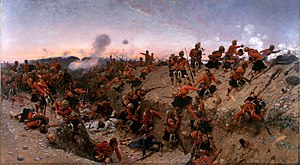Battle of Tel al-Kebir
| Battle of Tell El Kebir | |||||||
|---|---|---|---|---|---|---|---|
| Part of Anglo-Egyptian War | |||||||
 Battle of Tel el-Kebir painting by Alphonse-Marie-Adolphe de Neuville |
|||||||
|
|||||||
| Belligerents | |||||||
|
|
|
||||||
| Commanders and leaders | |||||||
|
|
|
||||||
| Strength | |||||||
| 13,000 troops 60 guns |
15,000 troops 60 guns |
||||||
| Casualties and losses | |||||||
| 57 killed 380 wounded 22 missing |
1,396 killed 681 wounded |
||||||
The Battle of Tell El Kebir was fought between the Egyptian army led by Ahmed Urabi and the British military near Tell El Kebir. After discontented Egyptian officers under Urabi rebelled in 1882, the United Kingdom reacted to protect its financial and expansionist interests in the country, and in particular the Suez Canal.
On May 20, a combined Franco - British fleet arrived at Alexandria. At the same time, Egyptian troops were reinforcing the coastal defenses of the city in anticipation of an attack. These events heightened tension in Alexandria, and eventually triggered tumultuous rioting with loss of life on both sides. As a result of the riots, an ultimatum was sent to the Egyptian government demanding they order Urabi's officers in Alexandria to dismantle their coastal defence batteries. The Egyptian government refused. Meanwhile, tension increased between Britain and France over the crisis, as most of the losses had been non-French, the principal European beneficiaries of the revolution would be the French. Thus, the French government refused to support this ultimatum and decided against armed intervention.
When the ultimatum was ignored, Admiral Seymour gave the order for the Royal Navy to bombard the Egyptian gun emplacements at Alexandria. On July 11 at 7:00 am, the first shell was fired on Fort Adda by HMS Alexandra (1875) and by 7:10, the entire fleet was engaged. The coastal defenses returned fire soon after, with minimal effect and minimal casualties to the British fleet. No British ships were sunk. On July 13, a large naval force landed in the city. Despite heavy resistance from the garrison for several hours, the overwhelming superiority of the smaller British forces eventually forced the Egyptian troops to withdraw from the city.
Lieutenant General Garnet Wolseley was placed in charge of a large force with the aim of destroying Urabi's regime and restoring the nominal authority of the Khedive Tawfiq. The total force was 24,000 British troops, which concentrated in Malta and Cyprus, and a force of 7,000 Indian troops which staged through Aden.
...
Wikipedia
